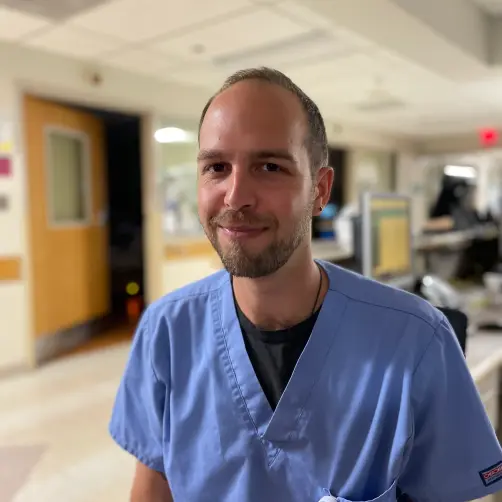
Table of Contents
Complex PTSD vs PTSD: What’s the Difference?

Written By: Ethan Cohen BSN, RN

Clinically Reviewed By: Dr. Don Gasparini
December 19, 2022
9 min.
Complex PTSD is a distinct type of PTSD that can have serious, long-term consequences on mental health. Read here to learn how it differs from PTSD.
Learn more about our Clinical Review Process
Table of Contents
Unfortunately, many people will experience a traumatic event at some point in their lifetime. According to the National Center for PTSD, about 60% of men and 50% of women experience at least one trauma in their lives. Women are more likely to experience sexual assault and child sexual abuse whereas men are more likely to experience accidents, physical assault, combat, disaster, or to witness death or injury.
Our body’s nervous system reacts to these experiences, which can have lasting effects on our mental and emotional well-being. While some traumatic events happen in a single occurrence, such as a car crash or a natural disaster, some people will experience chronic trauma that continues over a longer period of time.
Many people are familiar with post traumatic stress disorder (PTSD), but people may be less familiar with a newer diagnosis known as complex post traumatic stress disorder (CPTSD). CPTSD stems from repetitive, long-term trauma and can seriously impact mental health, relationships, and even daily functioning. This article will give a basic overview of the causes and symptoms of complex PTSD, what differentiates CPTSD from PTSD, and what treatment options are available for the disorder.

The origins of Complex PTSD
Over the past several decades, experts noticed that certain trauma victims exhibited a more severe pattern of psychological changes after prolonged or repetitive exposure to traumatic events. These individuals showed all the signs and symptoms of traditional PTSD such as intrusive memories or flashbacks, but also exhibited problems with self-organization such as excessive or heightened emotional responses, feelings of worthlessness, and persistent difficulties in sustaining relationships and feeling close to others.
Experts found that the difference between those exhibiting signs of traditional PTSD and what is now known as complex PTSD is the prolonged nature of their trauma, as well as the presence of additional symptoms.
What is prolonged trauma?
The types of trauma that typically lead to CPTSD are often extreme or take place over a long period of time. These can include:
- Torture
- Concentration camps
- Slavery
- Genocide campaigns
- Organized violence
- Domestic violence
- Childhood sexual or physical abuse
The key distinction in these types of trauma is that they are not one-off events. Another aspect of the trauma associated with complex PTSD versus PTSD is that the trauma is one that is difficult or impossible to escape. This characteristic is particularly important to consider in situations of “attachment trauma.”
According to Dr. Arielle Schwartz from the Center of Resilience Informed Therapy, “Often complex trauma begins in infancy. The nervous system of an infant is completely dependent upon caregivers to help them feel safe, connected, and calm. Growing up with parents who were dysregulated, abusive, or neglectful shapes a child’s vulnerable nervous system. This can lead to long-lasting patterns of emotional and physiological distress that get carried into adulthood.”
Do you need more support with
your mental health?
Charlie Health can help.
Symptoms of complex PTSD
In complex PTSD, the individual will exhibit symptoms associated with PTSD, which are as follows:
- Intrusion
People with PTSD may experience intrusive thoughts, such as nightmares, recurring memories, or flashbacks. It might feel like you’re reliving your worst memory or watching a recording of what happened, but you can’t step in and change it. - Avoidance
Many people with PTSD avoid reminders of the traumatic event, including people, places, activities, objects, sensory triggers, or similar situations. You might try to avoid remembering the traumatic event, talking about what happened, or acknowledging your feelings. - Alterations in cognition and mood
It might feel impossible to remember important aspects of the event. In some cases, negative thoughts and feelings can create distorted beliefs about oneself or others (i.e., “I can’t trust anyone”). You might lose interest in the things you used to enjoy, withdraw from loved ones, or have trouble feeling positive emotions. - Alterations in arousal and reactivity
Arousal and reactive symptoms might include increased irritability, angry outbursts, reckless behavior, or hypervigilance. It might feel like you can’t relax because you have to stay on “high alert” at all times.
After experiencing a traumatic event, a person may exhibit these symptoms, but they can eventually resolve after a short period of time. If they continue to persist for several weeks, it may be the case that the person is experiencing acute stress disorder. If the symptoms last for more than one month and have a negative effect on the individual’s ability to live their daily life, it is possible that they are experiencing PTSD. If the trauma that the person experienced happened repetitively and over a long period of time, as well as if there is the presence of disturbances in self-organization (DSO), it may be the case they are experiencing CPTSD.
Complex PTSD & disturbances in self-organization (DSO)
In addition to the symptoms listed above, it is common for people with complex PTSD to experience disturbances in self-organization, which can affect dysregulation, negative self-image or esteem, and disturbances in relationships. The National Center for PTSD explains these disturbances in greater detail:
- Emotional regulation
May include persistent sadness, suicidal thoughts, explosive anger, or inhibited anger. - Consciousness
Includes forgetting traumatic events, reliving traumatic events, or having episodes in which one feels detached from one’s mental processes or body (dissociation). - Self-perception
May include helplessness, shame, guilt, stigma, and a sense of being completely different from other human beings. - Distorted perceptions of the perpetrator
Examples include attributing total power to the perpetrator, becoming preoccupied with the relationship to the perpetrator, or preoccupied with revenge. - Relations with others
Examples include isolation, distrust, or a repeated search for a rescuer. - One’s system of meanings
May include a loss of sustaining faith or a sense of hopelessness and despair.
According to the CPTSD Foundation, “humans require safe people, safe places, and safe things during childhood and adolescence in order for healthy brain development to take place.” The complex PTSD foundation explains that due to the loss of their personal safety and agency during some of the most foundational stages in the brain’s development, adult survivors of complex trauma can experience a lack of self worth and a diminished sense of self. It is as if the experience has stunted their growth, making it far more difficult for them to progress into adulthood.
One of the most defining characteristics of CPTSD is the loss of a person’s sense of self and their ability to create and maintain meaningful relationships. The severity and pervasiveness of these issues in individuals who have suffered from repetitive, long-term trauma is one of the main differences between complex PTSD vs PTSD.
Controversy surrounding the complex PTSD diagnosis
During the late 1980s, Harvard University psychiatrist Dr. Judith Herman formulated a new diagnosis–complex PTSD–that better accounted for the symptoms present in people that had experienced long-term trauma. She believed that a traditional PTSD diagnosis could not adequately account for the breadth of symptoms that were found in victims of long-term trauma, and that these cases were significantly different from those of single-incident trauma.
Despite Dr. Herman’s argument for the necessity of a new diagnosis, complex PTSD is currently not recognized in the Diagnostic Statistical Manual of Mental Disorders (DSM5), the primary diagnostic tool used by clinicians to diagnose mental disorders in the United States. Critics of her work suggest that there is not enough empirical evidence to support the necessity of a separate diagnosis from traditional PTSD, and that while there are severe and complicated cases of PTSD, these cases do not represent a distinct trauma-related disorder.
That being said, some of the more recent revisions to the PTSD criteria in the DSM5 have been changed in order to include some of the symptoms that Dr. Herman witnessed during her formulation of complex PTSD. These include impulsivity, anger, emotional difficulties, and dissociation. For this reason, these examples of complex trauma retain the diagnosis of PTSD in the DSM5, and are not differentiated as CPTSD. Despite the DSM5’s reluctance to add “complex PTSD,” the World Health Organization (WHO), in its 11th revision of the International Disease Classification (ICD-11;6), has formulated the diagnostic criteria so that the difference between PTSD and CPTSD is substantial enough to include complex PTSD as a distinct diagnosis from PTSD.
Many clinicians have based their work on Dr. Herman’s research, further legitimizing the need to create a separate diagnosis for these unique cases of complex trauma.
Treatment for complex PTSD
Due to the reality that there is still a considerable amount of debate surrounding CPTSD, best practices for treatment of the disorder are still being formulated. The Complex Trauma Task Force of the International Society of Traumatic Stress Studies (ISTSS) released “The Expert Consensus Treatment Guidelines for Complex PTSD in Adults,” which proposed best practice guidelines for treatment. The ISTSS proposed a multiphase treatment plan for adults with complex PTSD:
- Phase 1
Ensuring the individual’s safety by reducing self-regulation problems and improving emotional, social, and psychological competencies symptom reduction, possibly through the use of medication education on the effects of long-term trauma teaching life and self care skills such as meditation and mindfulness. - Phase 2
Focusing on the trauma and the processing of the trauma memories recounting the traumatic experiences in a safe environment with the support of a well trained therapist. - Phase 3
Consolidate treatment gains and help the person adapt to current life circumstances establish healthy connections with friends and family collaborate with a therapist to make a plan to maintain progress.

While there is some debate about whether or not the ISTSS’s recommendation that avoiding trauma-focused care before first addressing some of the self-regulation problems is necessary for the successful treatment of CPTSD, there is a consensus that there are various psychotherapy modalities that are highly effective in treating the disorder. Psychotherapy, or talk therapy, allows the person living with complex PTSD to express themselves in a safe space with someone they can trust, and can give them an opportunity to address their past trauma and learn coping skills in order to begin to live a more manageable life.
Some types of therapy used in the treatment of complex PTSD include:
- Trauma-focused cognitive behavioral therapy (CBT) – Trauma-focused CBT creates a safe space to process traumatic experiences. This type of talk therapy can help you recognize problematic thought patterns that hold you back—for example, self-blame and guilt following a traumatic event. By reframing your perspective and rationalizing the problem, you can adopt an alternative mindset.
- Eye movement desensitization reprocessing (EMDR) – EMDR helps reduce the distressing symptoms associated with trauma based disorders. During EMDR sessions, your therapist will help you use eye movement techniques, such as back-and-forth-movements, to help your brain process traumatic memories. EMDR can help you replace negative reactions to traumatic experiences with more positive ones.
- Exposure therapy – Exposure therapy, a type of behavioral therapy, helps you safely face distressing memories so you can learn effective coping skills. Exposure therapy can be especially helpful for traumatic memories and nightmares.
Due to the severity and length of exposure to traumatic events that people with CPTSD have experienced, it is possible that treatment can last years. As research continues to grow on the topic of trauma and trauma-based disorders, the hope is that more clinicians will become familiar with trauma-informed care and those individuals who suffer from trauma-based disorders can eventually obtain easy access to the care they need.
How Charlie Health can help
If you’re struggling with unresolved trauma that’s affecting your ability to live a fulfilling life, we’re here to help. Our team of therapists and mental health experts can help you to better understand your relationship with your trauma and work with you to develop a plan of action. Complex PTSD and other trauma-related disorders can leave a person feeling hopeless, which can sometimes lead to developing harmful coping mechanisms. Our Intensive Outpatient Program can help give you the tools and personalized care you need to address your past trauma and move forward to a brighter and more manageable future





